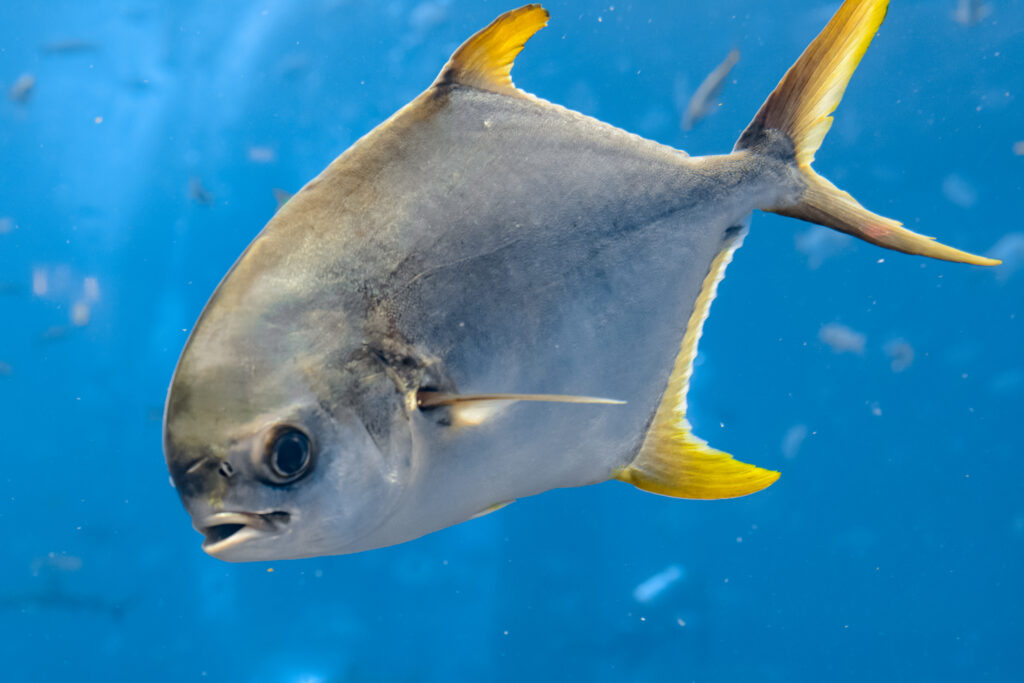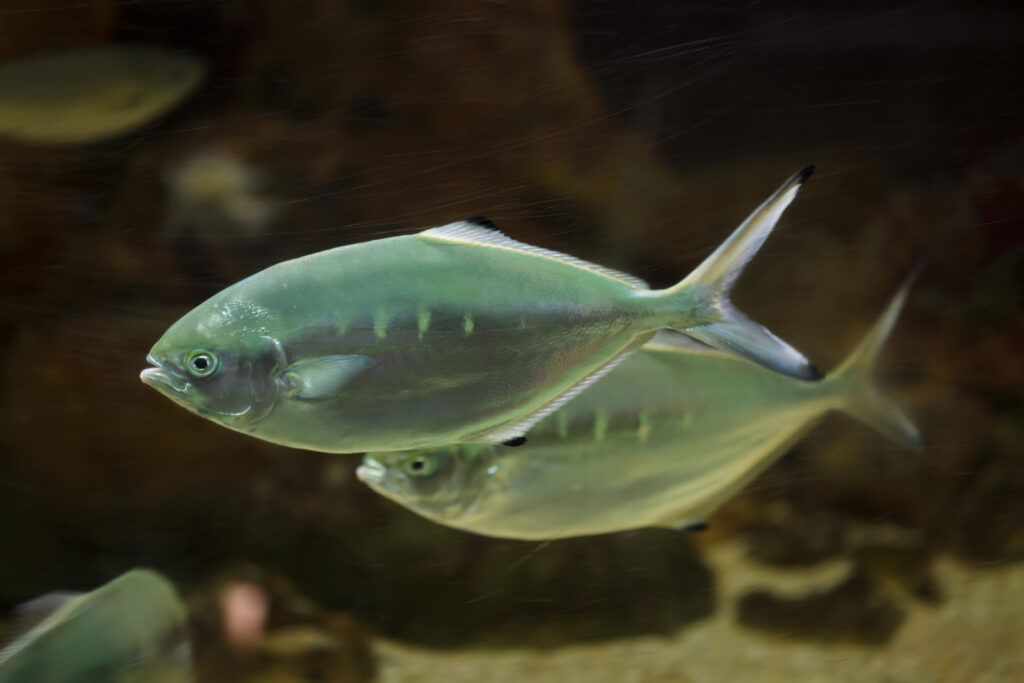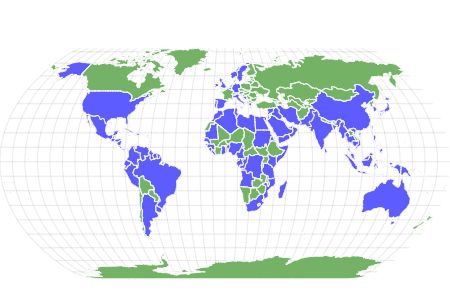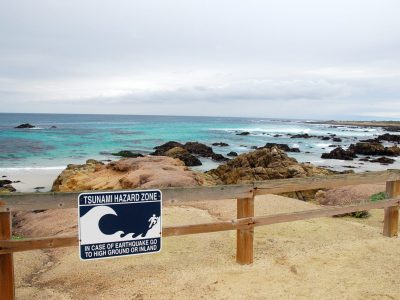Pompano Fish
They use their toothlike structures to crush the shells of crustaceans!
Advertisement
Pompano Fish Scientific Classification
Read our Complete Guide to Classification of Animals.
Pompano Fish Conservation Status
Pompano Fish Facts
- Prey
- Small fish, crustaceans, mollusks, worms
- Main Prey
- Crustaceans
- Name Of Young
- Fry
- Group Behavior
- Solitary
- School
- Solitary/School
- Fun Fact
- They use their toothlike structures to crush the shells of crustaceans!
- Biggest Threat
- Sharks
- Most Distinctive Feature
- Rounded faces
- Predators
- Sharks, birds, larger fish like flounder and striped bass
- Lifestyle
- Diurnal
- Crepuscular
- Common Name
- Pompano
- Number Of Species
- 21
- Slogan
- They are bottom-feeders
Pompano Fish Physical Characteristics
- Color
- Silver
- Skin Type
- Scales
- Length
- Less than 1.4 feet to four feet
- Venomous
- No
- Aggression
- Low
View all of the Pompano Fish images!
Pompano Fish Summary
Pompano fish are any 21 species of ray-finned fish within the genus Trachinotus. These fish inhabit warm coastal waters around the world with both commercial fisheries and sport fishers seeking out certain species. This includes the Florida pompano (an excellent food fish) and the permit (an exciting game fish). Pompanos are bottom feeders and the targets of larger fish, sharks, and birds.
3 Pompano Fish Facts
- Toothless: Pompanos don’t have a typical set of sharp teeth. Instead, some species have toothlike plates useful for crushing the shells of crustaceans.
- Bottom-feeders: These fish typically browse the ocean floor for their next meal. They seek organisms like small fishes, crustaceans, mollusks, and worms.
- Found in warm waters around the world: Pompanos are a common sight in warm coastal waters worldwide. This includes the Pacific, Atlantic, and Indian Oceans.
Pompano Fish Classification and Scientific Name
Pompano fish are within the family Carangidae (jacks and pompanos). The term “pompano” may encompass other species within this family. Additionally, it occurs in the common names of a few more distant species like the pompano dolphinfish (Coryphaena equiselis).
Within the kingdom Animalia, pompanos fall under the phylum Chordata. They also belong to the class Actinopterygii (ray-finned fishes) and the order Carangiformes (jacks). Some scientists classify them under the broader order of Perciformes (perch-like fishes).
Types of Pompano Fish: The 21 Different Species
The 21 species of pompano within the genus Trachinotus include:
- African or southern pompano (Trachinotus africanus)
- Oyster pompano (Trachinotus anak)
- Smallspotted dart (Trachinotus baillonii)
- Snubnose pompano (Trachinotus blochii)
- Largespotted dart (Trachinotus botla)
- Florida or common pompano (Trachinotus carolinus)
- Cayenne pompano (Trachinotus cayennensis)
- Swallowtail dart (Trachinotus coppingeri)
- Permit (Trachinotus falcatus)
- Palometa (Trachinotus goodei)
- Longfin pompano (Trachinotus goreensis)
- Blackblotch pompano (Trachinotus kennedyi)
- Marquesas dart (Trachinotus macrospilus)
- Plata pompano (Trachinotus marginatus)
- Guinean pompano (Trachinotus maxillosus)
- Indian pompano (Trachinotus mookalee)
- Pompano (Trachinotus ovatus)
- Paloma pompano (Trachinotus paitensis)
- Gafftopsail pompano (Trachinotus rhodopus)
- Steel pompano (Trachinotus stilbe)
- Shortfin pompano (Trachinotus teraia)
In addition to these species, other members of the Carangidae family from different genera may fall under the common term “pompano.” An example of such a species is the African pompano or threadfish (Alectis crinitis). This fish is not to be confused with the African pompano (Trachinotus africanus).

The snubnose pompano grows up to 3.6 feet in length.
©Endless luck/Shutterstock.com
Pompano Fish Appearance
Pompanos are typically toothless, deep-bodied, laterally compressed fish with narrow tail bases and forked tails. Their faces and dorsal regions are rounded, though their ventral regions are less so. Although their small scales are usually silvery, they may have yellowish or dark fins with dark markings on their bodies.
Pompanos vary somewhat in size. At the larger end of the scale, the snubnose pompano grows up to 3.6 feet in length while the permit grows to 4 feet and weighs as much as 79.4 pounds. By contrast, species like the Marquesas dart only grow to a maximum length of 1.4 feet. Similarly, the Florida pompano can be as small as 1.5 feet in length and as light as 2 pounds.
Pompano Fish Distribution, Population, and Habitat
Pompano fish are primarily marine fish, though some can also survive in brackish water. The shortfin pompano often enters freshwater rivers or streams. Several pompanos are reef-associated. Whether they are pelagic, benthopelagic, neritic, or demersal varies by species. These fish typically swim no deeper than about 656 feet, preferring to stay closer to the surface.
Pompanos inhabit warm waters worldwide. They live along the coasts of countries in North America, South America, Africa, Asia, Europe, and Oceania (including Australia). In the U.S., pompanos occur in Massachusetts, Rhode Island, Connecticut, New York, New Jersey, Delaware, Maryland, Virginia, North Carolina, South Carolina, Georgia, Florida, Alabama, Mississippi, Louisiana, and Texas.
Below is a table of the countries, islands, and regions with pompano fish.
Table of Countries, Islands, and Regions
| North America | South America | Africa | Asia | Europe | Oceania |
|---|---|---|---|---|---|
| Anguilla | Argentina | Algeria | Andaman Islands | Albania | Admiralty Islands |
| Antigua Barbuda | Brazil | Angola | Bahrain | Azores Islands | American Samoa |
| Aruba | Columbia | Benin | Bangladesh | Belgium | Australia |
| Bahamas | Ecuador | Cameroon | Cambodia | Bosnia and Herzegovina | Cook Islands |
| Barbados | French Guiana | Canary Islands | China | Channel Islands | Fiji |
| Belize | Galápagos Islands | Cape Verde | Christmas Island | Croatia | French Polynesia |
| Bermuda | Guyana | Cargados Carajos | Cocos Islands | Cyprus | Guam |
| Cayman Islands | Peru | Comoros | Denmark | Kiribati | |
| Costa Rica | Suriname | Congo | India | France | Lord Howe Island |
| Cuba | Uruguay | Democratic Republic of Congo | Indonesia | Germany | Marquesas Islands |
| Dominica | Venezuela | Djibouti | Iran | Gibraltar | Marshall Islands |
| Dominican Republic | Egypt | Iraq | Greece | Micronesia | |
| El Salvador | Equatorial Guinea | Israel | Ireland | New Caledonia | |
| Grenada | Eritrea | Japan | Isle of Man | Niue | |
| Guadalupe | Gabon | Kuwait | Italy | Norfolk Islands | |
| Guatemala | Gambi | Lebanon | Malta | North Marianas | |
| Haiti | Ghana | Malaysia | Monaco | Palau | |
| Honduras | Guinea | Maldives | Montenegro | Papua New Guinea | |
| Jamaica | Guinea-Bissau | Myanmar | Netherlands | Samoa | |
| Martinique | Ivory Coast | Oman | Norway | Solomon Islands | |
| Mexico | Kenya | Pakistan | Portugal | Tahiti | |
| Monserrat | La Reunion Island | Philippines | Slovenia | Tokelau | |
| Nicaragua | Liberia | Qatar | Spain | Tonga | |
| Panama | Libya | Saudi Arabia | Sweden | Tuamotu Islands | |
| Puerto Rico | Madagascar | Singapore | United Kingdom | Tuvalu | |
| St. Kitts and Nevis | Madeira Islands | South Korea | Vanuatu | ||
| St. Lucia | Mauritania | Sri Lanka | Wallis Futuna | ||
| St. Vincent and the Grenadines | Mayotte | Syria | |||
| Trinidad & Tobago | Morocco | Taiwan | |||
| United States | Mozambique | Thailand | |||
| Virgin Islands | Nigeria | Timor-Leste | |||
| Rodriguez | Turkey | ||||
| São Tomé and Príncipe | United Arab Emirates | ||||
| Senegal | Vietnam | ||||
| Seychelles | Yemen | ||||
| Sierra Leone | |||||
| Somalia | |||||
| South Africa | |||||
| St. Helena | |||||
| Sudan | |||||
| Tanzania | |||||
| Tanzania | |||||
| Togo | |||||
| Tunisia |
As of 2022, every pompano species from the Trachinotus family falls under the Least Concern or Data Deficient categories on the IUCN website. Pompanos do not appear to be endangered at this time.
Pompano Fish Evolution and History
The first fishes emerged during the Cambrian explosion about 530 million years ago. The Agnatha (jawless fish) evolved first with jawed fish developing during the Ordovician Period about 480 million years ago. Near the end of the Silurian Period (443.8-419.2 million years ago), bony fishes appear in the fossil record. This group eventually produced the class Actinopterygii (ray-finned fishes), producing the Carangiformes, including the pompanos.
Many evolutionary adaptations revolutionized the Carangiformes over millions of years, including changes to the dorsal fin structure and feeding apparatus. Specifically, the genus Trachinotus evolved toothlike structures capable of crushing the shells of crustaceans. This is more useful to pompanos as bottom-feeders than sharp teeth for gripping and tearing flesh would be.
Pompano Fish Predators and Prey
Pompano fish are predatory by nature. These carnivores are typically bottom-feeders. Additionally, other marine species, especially smaller species, prey on them frequently.
What Do Pompano Fish Eat?
Adult pompanos eat a variety of marine organisms including small fish, crustaceans (like crabs and shrimps), mollusks (like mussels), and worms. Juveniles subsist on benthic invertebrates until they mature.
What Eats Pompano Fish?
Pompanos have several natural predators including sharks, birds, and humans. Besides these threats, various larger fish species target them, including flounder, striped bass, weakfish, and bluefish.

Depending on the species, pompanos can live up to 23 years.
©Vladimir Wrangel/Shutterstock.com
Pompano Fish Reproduction and Lifespan
Though most pompano species remain in a marine environment to spawn, the shortfin pompano enters estuaries and may swim inland. Spawning for pompanos most often occurs in the spring or summer months. These fish are oviparous with the female laying eggs and the male fertilizing them. The eggs are typically pelagic. For the most part, juveniles remain in sheltered bays, surf zones, and estuaries.
Whether a pompano fish will school or remain solitary depends on its species. Some pompanos, like the Florida pompano, prefer to remain in small or large schools. Others, like the snubnose pompano, may school when in the juvenile stage but are typically solitary as adults. Yet others, like the African or southern pompano, have been known to behave both ways.
Depending on the species, pompanos can live up to 23 years, though most do not attain this advanced age. For example, the Florida pompano typically lives up to seven years.
Pompano Fish in Fishing and Cooking
Pompano fish are valuable to both commercial fisheries and recreational fishers worldwide. Some species, like the permit, make engaging game fish while others like the Florida pompano are excellent food fish. NOAA has identified the latter species as a vital part of expanding U.S. commercial aquaculture going forward.
Although most pompanos are good for eating, culinary experts widely consider the Florida pompano one of the world’s most edible fish. Though prices are high due to limited commercial landings, this species remains in high demand. Its silvery, edible skin compliments its mild, sweet flavor and firm, flaked meat.
The nutritional information for one serving of Florida pompano is as follows: 164 calories, 9.5 grams of fat, 18.5 grams of protein, and 0.6 grams of omega-3.
Related Animals
View all 192 animals that start with PPompano Fish FAQs (Frequently Asked Questions)
Where are pompano fish found?
Pompano fish are found in warm coastal waters throughout the world.
Are pompano fish good to eat?
Pompanos are popular food fish, especially the Florida pompano.
Are pompano fish healthy?
Pompanos are a great source of vitamins and healthy fats.
Are pompano fish endangered?
The IUCN lists several pompano species from the genus Trachinotus as Least Concern or Data Deficient categories.
Thank you for reading! Have some feedback for us? Contact the AZ Animals editorial team.
Sources
- BioOne Complete, Available here: https://bioone.org/journals/copeia/volume-108/issue-2/CI-19-320/The-Phylogeny-of-Carangiform-Fishes--Morphological-and-Genomic-Investigations/10.1643/CI-19-320.full
- NCCOS, Available here: https://coastalscience.noaa.gov/news/noaa-identifies-florida-pompano-as-commercially-ready-for-u-s-marine-aquaculture/
- Fishbase, Available here: https://www.fishbase.se/summary/1967https://www.fishbase.se/summary/1967
- Fishbase, Available here: https://www.fishbase.se/summary/380
- EOL, Available here: https://eol.org/pages/46578030
- Seafood Source, Available here: https://www.seafoodsource.com/seafood-handbook/finfish/pompano#:~:text=Gourmands%20describe%20the%20Atlantic%20pompano,primarily%20off%20Florida%27s%20west%20coast.
- Britannica, Available here: https://www.britannica.com/animal/pompano

















